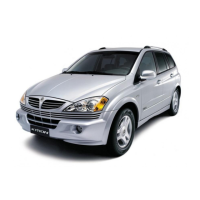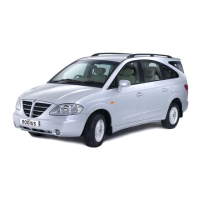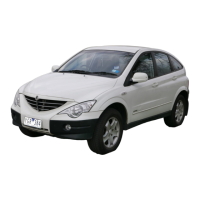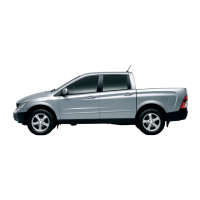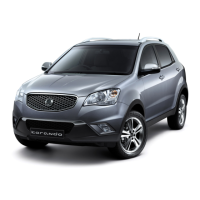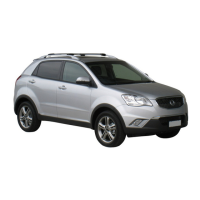Do you have a question about the SSANGYONG KYRON 2006 and is the answer not in the manual?
| Brand | SSANGYONG |
|---|---|
| Model | KYRON 2006 |
| Category | Automobile |
| Language | English |
Details the location and stamping of the engine number for different engine types.
Specifies the location of the chassis number stamped on the vehicle frame.
Indicates the location of the vehicle's certification label on the passenger's door sill.
Lists external checks including tires, fluids, cleanliness, hood, and surrounding area.
Lists internal checks including doors, seats, mirrors, seat belts, parking brake, and warning lights.
Specifies the required cetane rating for diesel fuel and cautions against low quality fuel.
Recommends octane ratings and warns about pre-ignition from low-octane gasoline.
Warns against using fuels containing methanol due to potential performance issues and damage.
Advises checking local regulations and fuel availability when operating the vehicle abroad.
Covers safe usage and handling of ignition keys and remote controls.
Explains crucial care for the turbocharger system to prevent seizure.
Outlines essential safety guidelines and precautions regarding the air bag system.
Warns against storing flammable items in the vehicle due to explosion risk.
Emphasizes using genuine parts for replacements to ensure safety and performance.
Provides guidelines on tire usage, maintenance, and potential issues from incorrect tires.
Details safe operation of power windows, especially with children, and anti-trap features.
Offers advice on cleaning and maintaining vehicle glass, including sensors.
Explains the importance and proper use of child restraint systems, including warnings about front airbags.
Provides detailed steps and warnings for starting the engine correctly, including diesel and gasoline engines.
Advises on the proper procedure for warming up the engine to ensure longevity and efficiency.
Offers guidance on operating the vehicle with an automatic transmission, including starting off and hill driving.
Highlights important advice for safe driving, such as avoiding distractions and proper pedal usage.
Warns against sudden maneuvers that can affect fuel economy and safety.
Provides crucial instructions for parking safely, including considerations for hills and unattended vehicles.
Details specific precautions for the DI diesel engine, emphasizing system integrity.
Explains the vehicle's safety mode operation in case of system errors.
Describes the function and operation of the supplementary heating device (PTC).
Explains the function of the engine check indicator and recommended actions.
Details the water separator warning light and necessary procedures for draining water.
Outlines the conditions and procedures for operating the priming pump.
Explains the operation of the door lock and unlock buttons on the remote control.
Describes the function of the panic button for emergency alerts.
Details how the immobilizer system prevents vehicle theft by matching key codes.
Describes how room lamps operate in conjunction with remote control key functions.
Explains the automatic locking feature when doors are not opened promptly.
Details how to activate the panic function to call for attention in emergencies.
Explains the dual functions of the door lock/unlock button on the remote control.
Describes the ACC position for operating electrical accessories with the engine off.
Explains the LOCK position for key insertion/removal and steering wheel locking.
Details the ON position for normal engine operation and accessory use.
Explains the START position for engaging the starter motor.
Provides steps to unlock the steering wheel using the ignition key.
Describes the illumination feature for the keyhole.
Explains the buzzer warning for leaving the key in the ignition.
Explains how the immobilizer works by matching key and ECU codes.
Describes the immobilizer indicator light and its meaning.
Explains the role of the immobilizer key in the system.
Advises on actions needed if the transponder is damaged.
Outlines steps to take if the vehicle key is lost.
Explains the procedure for locking all doors and the tailgate using the ignition key.
Describes how to unlock all doors and the tailgate with the ignition key.
Explains the automatic unlocking feature when the engine is switched off.
Details the conditions and procedures for arming the theft deterrent system.
Describes what happens when the theft deterrent system is triggered.
Explains how to disarm the theft deterrent system.
Explains the function of the door lock/unlock knob on the doors.
Describes how to use the door opening lever to access the vehicle interior.
Explains the child safety lock feature to prevent accidental door openings.
Explains the automatic door locking feature that activates at higher speeds.
Details the automatic unlocking function that occurs when the airbag deploys.
Describes how interior lamps synchronize with door switch operations.
Explains the window lock switch function to disable rear window operation.
Details the operation of the driver's window switches, including auto-up/down features.
Describes the operation of power window switches for passengers.
Explains the operation of rear window switches.
Describes the temporary operation of power windows after ignition is turned off.
Provides instructions for opening and closing the sunroof.
Explains how to tilt the sunroof up and down.
Discusses wind buffeting and how to adjust windows or sunroof to mitigate it.
Describes the anti-pinch safety feature that prevents trapping body parts.
Explains actions needed if sunroof operation is interrupted by battery issues.
Provides steps to recalibrate the sunroof starting point after power loss.
Explains how to operate the tailgate opening lever from the outside.
Describes how to use the tailgate opening lever from the inside.
Notes the child safety lock function affecting tailgate operation.
Describes the automatic light and rain sensor and its role in controlling headlights and wipers.
Explains the automatic light shut-off feature to prevent battery discharge.
Describes how to adjust headlight aiming angle based on vehicle load.
Explains how to activate the headlamp high beam and its indicator.
Describes how to use the passing light feature with the lever.
Details how to operate the front fog lights.
Explains the operation of the rear fog light switch.
Details the functions of the front wiper switch, including mist, off, auto, and speed settings.
Explains how to adjust wiper speed intervals in AUTO mode.
Explains how to operate the rear wiper and washer.
Details how to use the combined wiper and washer functions.
Describes the rain and auto light sensor functionality.
Details how the wipers operate in the AUTO position, including interaction with automatic lights.
Explains the basic operation of engaging cruise control and setting the speed.
Provides steps for setting and activating the cruise control speed.
Explains how to accelerate or increase speed while cruise control is active or inactive.
Details how to decelerate or decrease speed using cruise control functions.
Explains how to resume a previously set cruise control speed.
Lists the conditions under which the cruise control system is normally canceled.
Describes situations where cruise control may cancel abnormally and troubleshooting steps.
Provides guidance on using cruise control effectively on varying terrain.
Explains how to select the driver or passenger side mirror for adjustment.
Describes how to adjust the mirror position for optimal viewing.
Details the operation of the power folding feature for the outside rearview mirrors.
Describes how to temporarily disable the ESP system for better traction in slippery conditions.
Explains how to re-enable the ESP system after it has been disabled.
Explains how the ESP system works to maintain vehicle stability during critical situations.
Describes the Brake Assist System's role in optimizing braking force during emergencies.
Explains the ARP function's contribution to maintaining stability during potential rollovers.
Details the function of the HDC switch for controlling descent speed on steep grades.
Explains how to activate the heating elements for the tailgate and mirrors.
Describes the operation of the windshield heating system.
Explains how to activate the hazard warning flashers.
Explains how to cycle through ODO, TRIP A, and TRIP B display modes.
Provides instructions for resetting the TRIP A and TRIP B meters.
Explains how to activate and deactivate the HDC system.
Describes the meaning of the HDC indicator lights.
Details how the HDC system functions on steep grades.
Explains how to operate the windshield heating function.
Details the operation of the heated glass for the tailgate and mirrors.
Explains how to select different driving modes using the 4WD switch.
Details the procedure for changing driving modes between 2H, 4H, and 4L.
Explains how to operate the main switch for the front and center room lamps.
Describes the operation of the driver's side spot lamp.
Describes the operation of the passenger's side spot lamp.
Explains how to operate the sunroof using the switch.
Describes how to view and reset the odometer and trip meters.
Explains the indicator for the automatic transmission selector lever position.
Details the meaning of the battery charge warning light and its implications.
Explains the air bag warning light and what to do if it indicates a malfunction.
Explains the ESP warning light and its relationship to the ESPOFF switch.
Describes the HDC indicator light and its meanings.
Details the immobilizer indicator light and potential system issues.
Explains the seat belt reminder system for both driver and passenger.
Details the water separator warning light for diesel engines and required actions.
Explains the engine check warning light and its implications for vehicle operation.
Outlines the replacement schedule for the fuel filter.
Describes the water separating function of the fuel filter to protect the fuel system.
Describes the indicator for the 4WD High mode.
Details the indicator for the 4WD Low mode.
Explains the 4WD check warning light and when to have the system checked.
Details the engine overheat warning light and necessary actions.
Describes when the front fog light indicator illuminates.
Details when the high beam indicator illuminates.
Explains the warning light for open or improperly closed doors/tailgate.
Details the brake warning light, including parking brake and fluid level conditions.
Explains the low fuel warning light and the importance of timely refueling.
Describes the indicator for the winter mode selection.
Explains the glow indicator for diesel engines and its operation.
Details the EBD warning light and its function in distributing braking force.
Explains the warning light that illuminates when the engine hood is open.
Details the engine oil pressure warning light and its implications for engine damage.
Explains when the cruise control indicator illuminates.
Explains the function of the mode switch for winter and standard driving conditions.
Describes the shift lock release button and how to use it.
Details how to manually adjust gears using the selector lever in the "-D+" position.
Offers guidance on safely starting the engine and moving the vehicle from a stop.
Explains the vehicle's slow movement (creep effect) when not accelerating.
Explains how to use the kickdown function for rapid acceleration.
Details how to use the engine brake for slowing down and maintaining speed on descents.
Describes the P position for parking, warming the engine, or extended stops.
Explains the R position for reversing the vehicle and related systems.
Explains the Neutral position and associated safety precautions.
Describes the Drive position for normal driving and its automatic shifting behavior.
Provides instructions for starting off in 2nd gear using the winter mode.
Lists common symptoms indicating the transmission is in safety mode.
Provides steps to reset the automatic transmission's safety mode.
Details the operation of the obstacle detecting sensors and their role in the parking aid system.
Lists types of objects that the parking aid sensors may not detect.
Explains conditions where sensors might not detect obstacles properly.
Describes scenarios where sensors might work improperly but are not defective.
Details the function of the brake pedal for slowing and stopping the vehicle.
Explains the safety function that prevents simultaneous brake and accelerator pedal depression.
Describes the brake warning light, including its flashing and illuminating conditions.
Details the ESP warning light and its behavior when the system is active or off.
Explains how to disable the ESP function for better traction in slippery conditions.
Describes how to re-enable the ESP function after it has been stopped.
Explains the overall purpose and operation of the ESP system.
Explains how to activate and deactivate the HDC system.
Describes the meaning of the HDC indicator lights.
Details how the HDC system functions on steep grades.
Details the ABS warning light and its implications for braking.
Explains the EBD warning light and its function in distributing braking force.
Explains the ABS system's role in maintaining vehicle stability during braking.
Describes the EBD system's function in electronically distributing braking forces.
Explains the warning light and sound for driving with the parking brake engaged.
Details how to apply the parking brake lever.
Provides instructions on how to release the parking brake lever.
Explains how to adjust the seat's head restraint for proper positioning.
Details how to adjust the lumbar support for the driver's seat.
Explains how to operate the seat heater for comfort.
Describes the storage pocket located on the seatback.
Details how to adjust the seatback angle for comfort.
Explains how to move the seat forward or backward.
Provides steps to store preferred seat and mirror positions for multiple drivers.
Explains how to recall stored seat and mirror positions.
Explains how to adjust the head restraints for the second-row seats.
Details how to adjust the recline angle of the second-row seatbacks.
Explains the importance and correct method of fastening seat belts.
Explains how to adjust the seat belt height properly.
Describes the seat belt pretensioner function for frontal impacts.
Recommends seat belt usage for pregnant women for safety.
Emphasizes the use of appropriate child restraint systems for children.
Stresses the need for child restraint systems for young children.
Provides instructions on using child seat anchorages and securing the seat.
Explains the air bag warning light and its implications for system malfunction.
Describes the seat belt pretensioner function for frontal impacts.
Indicates the location of air bag warning labels on the sun visors.
Contains a specific warning statement for vehicles in Australia.
Details when the driver and passenger airbags deploy and when they may not.
Explains when curtain airbags inflate and the conditions under which they may not.
Recommends periodic inspection of the air bag system every 10 years.
Provides specifications and capacity for the vehicle's refrigerant.
Explains the PTC heater's role in enhancing cabin heating.
Describes the automatic mode for maintaining cabin temperature.
Explains how to manually control the climate system.
Explains how the AQS automatically adjusts air intake based on detected air quality.
Provides steps to clear fog from the inside of the windshield.
Explains how to clear fog from the outside of the windshield.
Explains how the AQS system automatically adjusts air intake based on detected air quality.
Explains the basic components and function of a turbocharger.
Highlights the benefits of using a turbocharger for engine performance.
Explains the function of the intercooler in cooling compressed air.
Explains how to operate the vehicle's horn.
Details how to adjust the steering wheel's position.
Explains how to manually adjust the inside rearview mirror.
Describes how to adjust the mirror for day/night visibility.
Describes the map pocket located on the front doors.
Describes the map pocket located on the rear doors.
Explains how to open and use the center console for storage.
Details the location and usage of the front cup holder.
Describes the overhead console features when the vehicle is equipped with a sunroof.
Describes the overhead console features when the vehicle does not have a sunroof.
Explains the function of the card holder for storing tickets and cards.
Details the operation of sun visors and the vanity mirror lamp.
Explains how to open and use the glove box.
Provides instructions for setting and adjusting the digital clock time.
Explains the function of the removable ashtray and its light.
Describes the additional front storage box location.
Explains how to operate the cigarette lighter in automatic transmission models.
Details how to operate the cigarette lighter in manual transmission models.
Explains the location and function of the front auxiliary power outlet.
Details the location and function of the rear auxiliary power outlet.
Describes the location and use of the rear center armrest.
Identifies the assist grips and coat hook locations.
Explains how to operate the front room lamp.
Details the operation of center room and luggage room lamps.
Explains how to operate the luggage room lamp.
Describes the location and use of the rear storage box.
Details the storage pocket located on the seatback.
Explains how to use the luggage net for securing items.
Describes the function of luggage hooks for securing loads.
Lists the types of discs compatible with the head unit and changer.
Lists the symptoms indicating engine overheating.
Describes symptoms that may occur after resetting the safety mode.
Provides steps to reset the automatic transmission's safety mode.
Identifies the locations of towing hooks for emergency towing.
Provides guidance on measuring and managing trailer weight for safe towing.
Provides instructions for parking a vehicle with a trailer on hills.
Highlights maintenance aspects crucial for vehicles towing trailers.
Provides immediate actions to take following a vehicle accident.
Details procedures for dealing with vehicle fires, including using extinguishers.
Lists recommended checks for the vehicle's exterior before driving.
Lists recommended checks for the vehicle's interior before driving.
Identifies key components within the D27DT diesel engine compartment.
Identifies key components within the D20DT diesel engine compartment.
Identifies key components within the gasoline engine compartment.
Provides instructions for checking and maintaining the engine oil level.
Details the procedure for adding engine oil.
Explains the role of engine oil in lubricating and cooling the engine.
Discusses factors affecting engine oil consumption.
Defines severe driving conditions that may require more frequent oil checks.
Outlines the recommended intervals for changing engine oil and filter.
Provides instructions for checking the coolant level in the surge tank.
Outlines the recommended service intervals for engine coolant replacement and checks.
Details how to clean the air cleaner element using compressed air.
Provides steps for replacing the air cleaner element.
Outlines the conditions for operating the priming pump.
Describes the water separating function of the fuel filter to protect the fuel system.
Outlines conditions for operating the priming pump after fuel filter maintenance.
Outlines the replacement schedule for the fuel filter.
Describes the water separating function of the fuel filter to protect the fuel system.
Identifies the location of the water separator in the engine compartment.
Provides instructions for draining water from the separator.
Outlines the replacement interval for the gasoline fuel filter.
Provides instructions for checking and replenishing brake and clutch fluid.
Details how to check and refill the washer fluid reservoir.
Provides guidelines for maintaining battery terminals and connections.
Lists the specifications for the vehicle's battery.
Identifies the locations of the interior fuse and relay boxes.
Provides recommended tire inflation pressures for driving and spare tires.
Explains how to check tire tread wear indicators.
Recommends regular tire rotation to prolong tire life.
Provides emergency use guidelines for the spare tire.
Advises on the use of winter tires for snowy or icy conditions.
Specifies that tire chains must be installed on rear wheels only.
Explains the periodic inspection of spark plugs for carbon deposits.
Details the procedure for replacing the drive belt on gasoline engines.
Provides the specification and capacity for transfer case oil.
Provides essential safety warnings and precautions for DIY maintenance.
Lists the specifications for various exterior and interior lamps.
Details how to check if lamps are working correctly and troubleshooting steps.
Details the procedure for replacing the front room lamp bulb.
Explains how to replace bulbs for center and luggage room lamps.
Provides advice for the first 1,000 km to ensure good vehicle performance and longevity.
Warns about the safe use of cleaning agents for the vehicle's interior and exterior.
Provides instructions for cleaning and maintaining seat belts.
Details how to clean vehicle glass surfaces regularly.
Provides guidelines for washing the vehicle to preserve its paint finish.
Recommends periodic polishing and waxing for paint surface protection.
Offers advice on cleaning and protecting bright metal parts.
Provides methods for cleaning wheels and wheel covers to preserve their appearance.
Emphasizes proper anticorrosion material application during body panel repairs.
Warns about damage from deposits and suggests cleaning methods.
Advises prompt repair of stone chips and scratches to prevent corrosion.
Recommends flushing corrosive materials from the underbody.
Lists essential checks before driving for safety and vehicle dependability.
Reminds drivers to check mirrors, brakes, lights, and seat adjustments.
Advises checking parts that may have been problematic.
Recommends checking tires, lights, and for oil stains.
Lists essential items to check in the engine compartment.
Stresses the importance of everyone wearing seat belts at all times.
Advises on ensuring children sit in the rear seat and are supervised.
Warns against leaving children unattended in the vehicle due to safety risks.
Provides guidance on actions to take if a warning light appears or a problem occurs while driving.
Highlights precautions against turning off ignition or manipulating switches while driving.
Advises against parking in areas with flammable materials.
Recommends turning off the engine when resting to prevent accidents.
Provides instructions for turning off the engine and securing the vehicle.
Stresses the importance of starting the engine before moving the vehicle.
Advises turning off the engine in enclosed spaces to prevent carbon monoxide poisoning.
Reminds drivers to check for obstacles when reversing.
Offers advice for driving safely in rain due to reduced traction.
Provides instructions for parking downhill, including gear selection and brake usage.
Details the procedure for parking uphill, including brake and gear application.
Warns against placing objects that could interfere with driving or cause fires.
Explains how to use engine brakes effectively on long downgrades.
Advises proper disposal of cigarettes and matches to prevent fires.
Warns against attaching accessories that may interfere with driving or cause fires.
Warns against opening the coolant tank cap when the engine is hot.
Emphasizes using genuine parts for safety and performance.
Provides advice for safe driving on snowy or icy roads.
Offers guidance for driving on sandy or muddy roads to avoid getting stuck.
Provides precautions for driving on unpaved and mountain roads.
Details precautions for driving through water to prevent vehicle damage.
Lists critical reminders for driving through water and checking the vehicle afterward.
Advises on inspecting the vehicle for damages after driving through water.
Provides guidance on gear selection and brake usage when driving on hills.
Warns against modifying vehicle circuits and using non-genuine fuses.
Warns about potential issues with window tinting, especially for navigation systems.
Highlights risks associated with using non-specified tires and wheels.
Recommends regular checks and maintenance to ensure vehicle performance.
Lists the specifications for various exterior and interior lamps.
Details how to check if lamps are working correctly and troubleshooting steps.
Details the procedure for replacing the front room lamp bulb.
Explains how to replace bulbs for center and luggage room lamps.
Provides advice for the first 1,000 km to ensure good vehicle performance and longevity.
Warns about the safe use of cleaning agents for the vehicle's interior and exterior.
Provides instructions for cleaning and maintaining seat belts.
Details how to clean vehicle glass surfaces regularly.
Provides guidelines for washing the vehicle to preserve its paint finish.
Recommends periodic polishing and waxing for paint surface protection.
Offers advice on cleaning and protecting bright metal parts.
Provides methods for cleaning wheels and wheel covers to preserve their appearance.
Emphasizes proper anticorrosion material application during body panel repairs.
Warns about damage from deposits and suggests cleaning methods.
Advises prompt repair of stone chips and scratches to prevent corrosion.
Recommends flushing corrosive materials from the underbody.
Lists essential checks before driving for safety and vehicle dependability.
Reminds drivers to check mirrors, brakes, lights, and seat adjustments.
Advises checking parts that may have been problematic.
Recommends checking tires, lights, and for oil stains.
Lists essential items to check in the engine compartment.
Stresses the importance of everyone wearing seat belts at all times.
Advises on ensuring children sit in the rear seat and are supervised.
Warns against leaving children unattended in the vehicle due to safety risks.
Provides guidance on actions to take if a warning light appears or a problem occurs while driving.
Highlights precautions against turning off ignition or manipulating switches while driving.
Advises against parking in areas with flammable materials.
Recommends turning off the engine when resting to prevent accidents.
Provides instructions for turning off the engine and securing the vehicle.
Stresses the importance of starting the engine before moving the vehicle.
Advises turning off the engine in enclosed spaces to prevent carbon monoxide poisoning.
Reminds drivers to check for obstacles when reversing.
Offers advice for driving safely in rain due to reduced traction.
Provides instructions for parking downhill, including gear selection and brake usage.
Details the procedure for parking uphill, including brake and gear application.
Provides advice for safe driving on snowy or icy roads.
Offers guidance for driving on sandy or muddy roads to avoid getting stuck.
Provides precautions for driving on unpaved and mountain roads.
Details precautions for driving through water to prevent vehicle damage.
Lists critical reminders for driving through water and checking the vehicle afterward.
Advises on inspecting the vehicle for damages after driving through water.
Provides guidance on gear selection and brake usage when driving on hills.
Warns against modifying vehicle circuits and using non-genuine fuses.
Warns about potential issues with window tinting, especially for navigation systems.
Highlights risks associated with using non-specified tires and wheels.
Recommends regular checks and maintenance to ensure vehicle performance.
Lists the specifications for various exterior and interior lamps.
Details how to check if lamps are working correctly and troubleshooting steps.
Details the procedure for replacing the front room lamp bulb.
Explains how to replace bulbs for center and luggage room lamps.


